Jefferson Lab Newsletter is an online publication providing information on the lab. It is published twice a month. In order to get updates, please subscribe to the news feed.
 |
Welcome to the first issue of Jefferson Lab's electronic newsletter
|
 |
Department of Energy Secretary Bodman visits, announces CD-1 for the 12 GeV Upgrade project
|
 |
Pocket-sized physics detector does big science
|
 |
2006: Change the World with Science
|
 |
Nine teams compete in March 11 Virginia Middle School Science Bowl
|
 |
User Liaison Office vacancy filled by R. Harris
|
 |
DOE Launches New Energy.Gov Website
|
 |
Exploring nature, exploring science planned for Take Our Children to Work Day event |
Welcome to the first issue of Jefferson Lab's electronic newsletter (top ^)
Welcome to the first issue of the electronic OnTarget - or e-OnTarget - Jefferson Lab's twice monthly newsletter! This electronic newsletter will be emailed to all JLab employees and users and anyone else (upon request) interested in Jefferson Lab's world-class nuclear physics research program, its unique applied research activities, and the people and events that make up Jefferson Lab.
If you received this email, Jefferson Lab's Public Affairs office considers you part of the JLab community. If you know of someone who would be interested in reading JLab's e-newsletter, please forward it to them. We'll be bringing you stories about what your colleagues are doing in nuclear physics research using JLab's Continuous Electron Beam Accelerator Facility (CEBAF) as well as other areas of research and technology development at the Lab. We want to hear what you're doing as well. Email magaldi@jlab.org with your comments, ideas, or articles. For additional information about Jefferson Lab, please use the links in the left column.
This electronic newsletter will consist of short feature stories and news items highlighting science, safety, technology transfer, people and significant events and awards. Many of the items found in the Briefs section of the (former) print version of the newsletter have migrated to JLab's Insider page or the We Hear That page. Both are accessible on JLab's local area network to everyone with a JLab computer account. The e-OnTarget will be available from JLab's News web page in a print-friendly mode for individuals who prefer to read a print version of the newsletter.
Department of Energy Secretary Bodman visits, announces CD-1 for the 12 GeV Upgrade project (top ^)
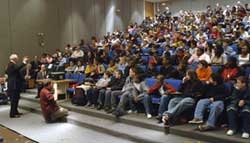
Secretary Bodman helps sixth grade students explore the different states of matter.
On February 22, Energy Secretary Samuel Bodman visited Jefferson Lab, starting his day with an address to Lab staff and users. Secretary Bodman emphasized safety in the workplace by expressing his concern for the "personal safety of all employees" believing "that the effectiveness of an organization can be gauged by how employees take care of each other." He commended the Lab on its safety record and emphasized the fact that DOE and contractors have to work together as a team to ensure outstanding performance.
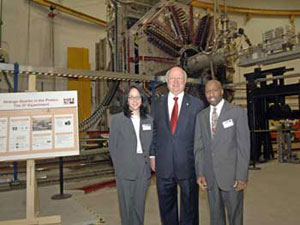
College of William and Mary PhD candidate Stephanie Bailey and Hampton University PhD candidate Leon Cole pose for a photo with Secretary Bodman after his tour of Hall C.
Secretary Bodman announced the signing of CD-1 for the 12 GeV Upgrade project. He also announced the inclusion of $7M in the President's FY2007 budget request for project engineering and design. Secretary Bodman views the 12 GeV project as providing a compelling research program for the Lab and User community for years to comee.
Secretary Bodman applauded the Lab's science education programs for students and teachers, and highlighted the critical importance of such programs in helping the United States remain the world leader in science.
Congresswoman Jo Ann Davis, Congressman Bobby Scott, City of Newport News Mayor Joe Frank, Office of Science Director, Ray Orbach, and the Associate Director for Nuclear Physics, Dennis Kovar, accompanied Secretary Bodman as he toured the Machine Control Center, Hall C and the Free-Electron Laser. The group participated in Becoming Enthusiastic about Math and Science (BEAMS) science education activities and talked to local middle school teachers enrolled in the DOE-sponsored Teacher Academy in Physical Science program at JLab. The Secretary concluded his day with a visit to the interactive Physics Fest program offered to area middle schools. He talked with over 200 sixth graders about the value of understanding science and his personal experiences as a young scientist.
Pocket-sized physics detector does big science (top ^)

 Compact detector on display in CEBAF Center lobby.
Compact detector on display in CEBAF Center lobby.
What a BONUS! Compact detector package for Hall B experiment goes on display in CEBAF Center lobby. Check it out the next time you visit CEBAF Center.
How do quarks and gluons, the elementary constituents of all matter, combine to form the protons and neutrons in the nucleus of the atom? This is a fundamental unsolved question in nuclear physics that researchers at Jefferson Lab are working to answer. The internal structure of the proton has been studied for several decades, and scientists have learned a great deal. However, much less is known about the structure of the neutron.
To study the nucleus of the atom and its building blocks at JLab, nuclear physicists start with a stream of electrons from CEBAF, JLab's accelerator. The electrons strike a target, and as they pass through, some collide with the particles that make up the target. Physicists learn about these particles by using detectors placed around the target to record information about the electrons that scattered and about the particles that are knocked out.
Hydrogen is a good target material for studying the proton this way. It's nucleus is a single proton, so studying it is synonymous with studying a "free proton." However, there are is similar material for studying neutrons. The only neutrons that can be studied with accelerators are found bound together with protons inside nuclei. The nucleus of deuterium is composed of one proton and one neutron and is the simplest nucleus containing neutrons. The difficulty with using deuterium as a target to learn about neutrons, however, is that the structure of a neutron is altered when it is bound up inside a deuterium nucleus.
To overcome this problem, the BONUS (Barely Off-shell NUcleon Structure, or BOund NUcleon Structure) experiment at JLab used a novel technique in which electrons collide with neutrons in the deuterium nucleus at a moment when they are only loosely bound inside the nucleus, appearing as if they are "nearly free."
To pick out and measure these particular weakly-bound neutrons, scientists needed to detect protons that were moving very slowly relative to the neutrons inside the nucleus. These protons are difficult to detect, because they don't travel very far before losing all their energy and coming to a halt. With the original experimental equipment at JLab, the protons would have stopped before reaching the detectors. So physicists built the BONUS detector. This detector could be placed close enough to the target to capture these very important protons (or VIPs, as the BONUS scientists call them) as they straggled away from the nucleus.
The data from this experiment, which was staged in Hall B, October through December 2005, will allow physicists to unambiguously examine the structure of a nearly-free neutron, providing a much more comprehensive picture of these building blocks of matter.
The (functional spare) BONUS detector - a Radial Time Projection Chamber - is currently on display by the main stairway in the CEBAF Center lobby. The spare was installed in CLAS for the June 2005 test run but a different (identical) one was used in the late-2005 production run. That detector functioned throughout the experiment's run, so the spare was not called upon. The Radial Time Projection Chamber, which weighs just about 5 pounds and measures less than 10 inches long, was placed inside Region 1, the innermost part of the CLAS detector.
2006: Change the World with Science (top ^)
Thomas Jefferson High School for Science & Technology wins Regional Science Bowl 5th year straight


Finishing in first place at the Virginia Regional High School Science Bowl was the team from the Thomas Jefferson High School for Science and Technology from Alexandria. Pictured from left to right is Coach Sharon Webb, Charlotte Seid, Daniel Schafer, Lisa Marrone, Neel Kotra and Logan Kearsley.
After a slow start, the Thomas Jefferson High School for Science and Technology team prevailed at the 2006 Virginia Regional High School Science Bowl on Feb. 11, making this the team's fifth consecutive year finishing in first place. The win gives the Alexandria team a berth at the National Science Bowl® competition being held in Washington, D.C., April 27 through May 1. For the last four years, the TJHSST team has gone on to win Science Bowl nationals.
The TJHSST team lost one match, and at halftime in another match was behind 40 to 0, during the morning round-robin session. But in the end TJHSST beat out 19 other teams and took home a $600 check for its school, the regional banner the team will carry to nationals, a team trophy, and individual medals.
T.C. Williams High School, also from Alexandria, took second place, and received a $400 check and a team trophy. Finishing in third was Charlottesville High School, Charlottesville; the team went home with a $300 check and a team trophy. Langley High School, McLean, rounded out the group of top finishers with fourth place.

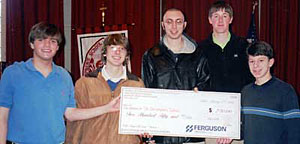
St. Christopher's School, out of Richmond won the Ferguson Enterprises-sponsored "Stay All Day" competition and received a $250 check from Ferguson. The team includes (from left to right) Charles Ellen, Luke Morris, Robin Marschak, James Smyth, and Daniel Fletcher. The team is coached by chemistry teacher Vicki Hurt.
The National Science Bowl® program is a highly visible educational event and academic competition among teams of high school students. They compete in an intense question-and-answer format, solving technical problems and answering questions in chemistry, biology, physics, mathematics, astronomy, and the general, earth and computer sciences. The regional and national events encourage student involvement in math and science activities, improve awareness of career options in science and technology, and provide an avenue of enrichment and reward for academic achievement. The Science Bowl program has been sponsored since 1991 by the U.S. Department of Energy.

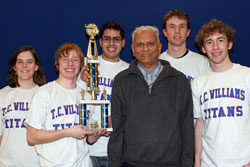
Taking home the second place trophy from the Virginia Regional High School Science Bowl was the team from T.C. Williams High School from Alexandria, Va. Pictured from left to right is Rachel Brown-Glazner, Ian Waters, Edward Montiel, Coach Manu Patel, Charles Slominski and Todd Bernhard.
Many of the teams eliminated from competition after the morning rounds stayed for the afternoon to participate in a series of math and science challenges dubbed the Ferguson Enterprises "Stay All Day" contest. St. Christopher's School, Richmond, Va., won the Ferguson-sponsored competition and received a $250 check from Ferguson, a nationwide wholesale plumbing and heating equipment and supplies distributor headquartered in Newport News. Activities included determining the mass of an object using balance and a little math; calculating where to place a target so the target would be hit by a ball rolling down an inclined plane and freefalling onto the target; and determining the distance between the sun and each planet for a scale-model of the solar system. St. Christopher's team won with the best composite score for the three activities.
Jefferson Lab has hosted this annual event since 2002. More than 70 JLab employees and their family members turned out to help with the event. Volunteers served as tournament moderators, science judges, rules judges, timekeepers and scorekeepers. "The volunteers made this event a great success," says Jan Tyler, Science Education program manager. "Students, teachers, and parents were very complimentary of our officials and JLab's hospitality. I want to thank all of the volunteers for making this a special day for so many students and teachers."
"Events like this are vital because they champion an interest in science and math among our nation's youth," Tyler notes. "An event like this is a great way to promote education, academic excellence and an interest in math and science. These events give us the opportunity to encourage and motivate young minds. By hosting the regional science bowl, JLab is able to show support for science education in Virginia and encourage our youth to pursue a higher education and careers in science and math."
Nine teams compete in March 11 Virginia Middle School Science Bowl (top ^)


The Peasley Middle School team from Gloucester is coached by Ray Yoh (far right). The team (from left to right) includes Sayer Fisher, William Wei-Xi Wang, Tavis Sparrier (holding trophy), and Caleb Dyke. Photo courtesy of Jefferson Lab.
The Virginia Regional Middle School Science Bowl (MSSB) drew a crowd of more than 200 to Jefferson Lab on Saturday, March 11. More than 120 family members showed up to watch nine teams compete in the Department-of-Energy-sponsored, academic tournament.
At the end of the day-long event, Peasley Middle School, Gloucester, finished in first place and will advance to the Middle School Science Bowl Nationals set for June in Denver, Colorado. Second place was won by Northampton Middle School, Machipongo; and James Blair Middle School, Williamsburg, and Chancellor Middle School, Fredericksburg, rounded out the top spots in third and fourth place, respectively.
"I was surprised at the end result," comments Jan Tyler, Science Education program manager. "The Northampton team won all of its matches until the first finals match (Double Elimination, Round 6) and then lost twice to Peasley, whom the Northampton team had beaten in Round 3 of the Double Elimination."

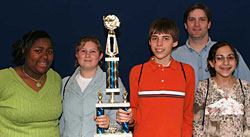
The Northampton Middle School team, from Machipongo landed second place at the March 11 Science Bowl. The team includes (left to right) Jessica Lee, Kendall Combs, Kevin Edelmann and Mitra Sedghi. They are coached by Michael Bono (back, far right).
The Peasley team coach, Ray Yoh, might have a competitive edge, according to Tyler. Yoh has spent part of each of the last two summers at JLab, participating in the Teacher Academy in Physical Science (TAPS) program. He will return this summer for his final session in the three-year enrichment program designed to build teachers' skills in the physical sciences. The four-week summer program is for teachers of grades 5 through 8.
And what a difference a year can make. Last year the Northampton team didn't advance into the afternoon session. This academic year the same team (now eighth graders) has had a physical science class and finished in second place, according to Tyler.
"It was a great day," comments Tyler. "The students always have so much fun at this event. It's a thrill to see all the smiles. Even the teams that fell out of the competition after the morning session enjoyed competing and left with big smiles."
Her goal for the 2007 MSSB is to have more teams competing. "I'd really like to see 12 to 15 teams competing at the middle school event next year. Middle school is the ideal time to capture students' interests and excitement in math and science." The registration deadline for the 2007 MSSB will be in December 2006. Tyler encourages teachers to contact her or visit JLab's Science Education webpage or the DOE MSSB webpage for more information.
Additionally, Tyler thanks the 26 JLab employees and their family members who volunteered as moderators, science judges, rules judges, timekeepers and scorekeepers for the day-long event. "Many thanks to all our volunteers for doing such a great job! All your help and support make the Science Bowl such a fun event for all the kids and for me as well. You are awesome volunteers; thanks for your enthusiasm!"
User Liaison Office vacancy filled by R. Harris (top ^)


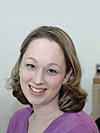
(left to right) Rachel Harris and Lorelei Carlson
Early this month, Physics Division administrative assistant Rachel Harris moved into the User Liaison Office opening left by Karen Owens, who resigned her position with JLab to embark upon a teaching career.
Rachel assumes the role of User Liaison Office Administrator for the Physics Division and takes over all duties associated with that office. Rachel has been with Jefferson Lab for more than 11 years, supporting the Hall C Group and its User community and is now the User community's primary contact at Jefferson Lab for user-related issues and concerns. Her office is room L111 in CEBAF Center. Rachel can be emailed at harris@jlab.org.
Lorelei Carlson, who has been a CEBAF Center front desk receptionist since November 2005 is now responsible for Hall C administrative support. Lorelei's email is lcarlson@jlab.org.
DOE Launches New Energy.Gov Website (top ^)
Early this year Secretary of Energy Samuel W. Bodman unveiled an updated version of the Department of Energy's (DOE) website, http://energy.gov/. The DOE website features a new look and enhanced user-centered navigational tools and search capabilities.
"Energy.gov is a key resource for millions of Americans each year," Secretary Bodman said. "Our redesigned Energy.gov site allows for quicker and easier access to information about DOE's programs and initiatives, including easy to use ways families and businesses can save money and energy."
The refurbished site allows for easier navigation by organizing content into easy-to-use categories, such as educational resources for parents, teachers and students. Additionally, energy.gov highlights new state-by-state information pages detailing each state's respective energy activities and resources. The new site also links users to the latest news on the activities of the department and its national labs and sites across the country.
Energy.gov operates under a new content management system that allows content managers to easily update the site with up-to-date information. This program also assists in streamlining the internal workflow processes and overall site management.
Exploring nature, exploring science planned for Take Our Children to Work Day event (top ^)
Jefferson Lab's Take Our Children to Work Day will be Thursday, April 20. Registration for the event is required and can be completed through April 14 on the Science Education web page. Go to the column on the right side of the web page. The event is open to the 1st through 6th grade children or grandchildren of JLab employees, users and contractors.
The event will start with sign-in from 1 to 1:30 p.m. in the CEBAF Center lobby. Participants will move to the auditorium for a 40-minute "Critters in Your Backyard" show presented by the Virginia Living Museum. From there the group will go to the VARC and break into three groups. Each group will rotate through the three "Exploring Science" activities that will be set up.
As this is an afternoon-only activity, snacks won't be provided, according to Science Educations' Dave Abbott. "So, please make sure your child eats lunch before the afternoon's activities begin." The program will end at 5 p.m. and Abbott reminds JLab parents/sponsors to plan on picking their children up promptly at 5 p.m.
Abbott needs about eight more volunteers to help with the event. Adults available to help with all or part of the afternoon are asked to contact Dave at davida@jlab.org or call ext. 7633.

